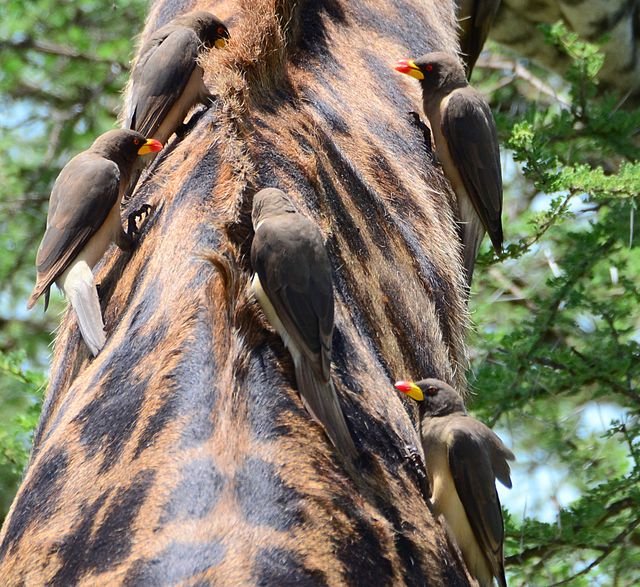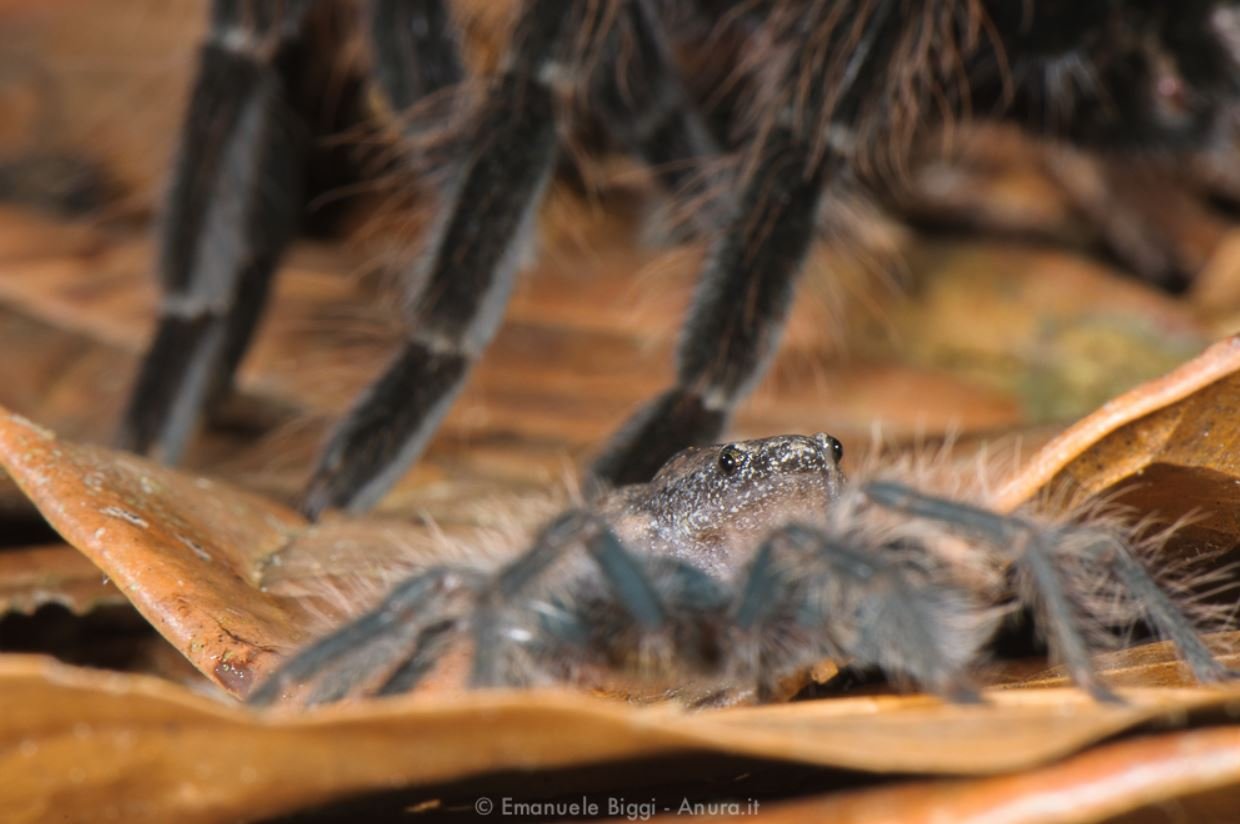Caption: tarantula walking over a Dotted humming frog. Photo by Emanuele Biggi of Anura. Used with permission.
Microhylids – or narrow-mouthed frogs – are not exactly the superstars of the frog world: they’re only really familiar to specialists, despite the fact that (as of August 2022) they contain over 735 species distributed across Africa, Madagascar, the Americas, and Asia. However, some recent research on the group shows that, like so many animals, they’re really quite interesting once you get to know them.
Caption: lest we forget, there are a lot of frogs. Here's an excerpt from a developing montage for my in-prep textbook on vertebrate history. Other versions viewable at the Tet Zoo patreon site. Image by Darren Naish.
You might be surprised to learn that microhylids in Peru, India, Sri Lanka and perhaps elsewhere have developed close relationships with large spiders. Crocraft & Hambler (1989) provided one of the first published discussions of this phenomenon. Noting a close association between individuals of the Dotted humming frog Chiasmocleis ventrimaculata and the burrowing theraphosid tarantula Xenesthis immanis in southeastern Peru (but read on), they suggested that the spider – well capable of killing and eating a frog of this size – used chemical cues to recognise the frogs. Young spiders have sometimes been observed to grab the frogs, examine them with their mouthparts, and then release them unharmed. Microhylids are probably unpalatable due to their skin toxins, and this might explain how this association arose in the first place.
Caption: big spiders of several kinds are quite capable of killing and eating small frogs and toads. Here, the unlucky victim is a leaf-litter toad. Photo by Brian Gratwicke, CC BY 2.0.
Crocraft & Hambler (1989) noted that the frog seemed to benefit from living in proximity to the spider by eating the small invertebrates that were attracted to prey remains left by the spider. The frog presumably also benefits by receiving protection: small frogs like this are preyed on by snakes and large arthropods, yet on this occasion we have a frog that receives a sort of ‘protection’ from a large, formidable spider bodyguard. Hunt (1980) suggested that the spider might gain benefit from the presence of the frog: microhylids specialise on eating ants, and ants are one of the major predators of spider eggs. By eating ants, the microhylids might help protect the spider’s eggs. Hmm, interesting…
Caption: Pamphobeteus nigricolor, a theraphosid spider closely related to some of the taxa mentioned here. Photo by Ltshear, in the public domain.
In an unpublished masters report from 2002, Jolene Csakany examined the relationship observed between the Dotted humming frog and two kinds of theraphosid, again in Peru. Csakany was unable to identify the spiders concerned: she noted that Crocraft & Hambler’s (1989) identification of X. immanis might be incorrect as this spider is otherwise thought to be absent from Peru. Furthermore, X. immanis has some bright pink on its dorsal surface, whereas the spiders observed by Csakany were either robust and solid black, or less robust, and with red hairs on their abdomens. The black spider might be a new species of Pamphobeteus, known locally as the chicken spider (due to an anecdotal account where one carried off a chick!), but the fact that Csakany observed two different kinds of Peruvian tarantula suggests that humming frogs might have formed relationships with more than one tarantula species.
Csakany placed skin from humming frogs onto the body of a frog that does not seem to have any special relationship with tarantulas and is ordinarily eaten by them (the Lowland tropical bullfrog Leptodactylus andreae, a leptodactylid. Csakany used one of its synonyms: Adenomera andreai [sic]). After grabbing the skin-wearing Leptodactylus specimens, the spiders examined them, and released them unharmed. Again, this supports the hypothesis that the tarantulas recognise ‘partner’ frogs after receiving certain chemical signals.
Caption: Sri Lankan bullfrog or Sri Lankan painted frog Uperodon taprobanicus. Image by Biswarup Ganguly (original here), CC BY 3.0.
Another relationship between a microhylid and a spider was reported on Rameshwaran Island (off the south-east coast of India) by Siliwal & Ravichandran (2008). These authors reported that they first became alerted to the possibility of an unusual relationship between the arboreal tarantula Poecilotheria and the microhylid Uperodon taprobanicus* after seeing individuals of both species emerge from the same tree hole, and then stand in close proximity without the spider showing any predatory interest in the frog (recall that big spiders will ordinarily eat small frogs if the situation allows). And Poecilotheria is a large, aggressive tarantula, quite capable of killing and eating small frogs.
* This frog was formerly included in the genus Kaloula, as Kaloula taprobanica. Siliwal & Ravichandran (2008) accidentally spelt the species name taprobranica [sic]. A bit embarrassing, perhaps, as Taprobane is the old name for Sri Lanka.
Caption: image from Siliwal & Ravichandran (2008), showing U. taprobanicus on the left, the spider on the right, and the shared tree hole in the middle.
More recently, Karunarathna & Amarasinghe (2009) reported close relationships between the microhyline Uperodon nagaoi (formerly Ramanella nagaoi) and the theraphosids Poecilotheria ornata and P. cf. subfusca in Sri Lanka. The frog and the tarantulas shared tree holes, and a number also contained eggs and/or juveniles of the spider, or eggs and/or juveniles of the frog, or eggs and/or juveniles of both ‘partner’ species. Karunarathna & Amarasinghe also cite a very obscure published report by G. Miller from 2003 where a South American microhylid (this time the Bolivian bleating frog Hamptophryne boliviana) was observed in close association with the theraphosid Xenesthis immanis. Unlike Uperodon (which is a microhyline microhylid), Hamptophryne is a gastrophrynine, as is Chiasmocleis. For the significance of this, read on.
Caption: oxpeckers on giraffe.. a relationship often thought of as a good example of commensalism. But is it? Actually, it's complicated (as you might know if you're a long-time TetZoo reader). Image by René Mayorga, CC BY-SA 2.0.
Complex relations: commensalism… or mutualism? The various papers you’ve just been reading about frequently refer to these microhylid-tarantula associations as examples of commensalism. Commensalism, as I’m sure you know, is the phenomenon whereby species strike up a relationship that is beneficial to one, but has no real cost or benefit to the other. So, if a small, insectivorous bat sleeps in the roof of the house you build, the bat is benefiting from your house, but you essentially gain nothing, and nor does the bat exact any sort of cost on you or the resources you rely on. If these microhylids and spiders do have a commensal relationship, I presume the thinking is that the frog receives protection from predators thanks to its association with the spider, but that the spider gets nothing in return.
Caption: a juvenile Pamphobateus tarantula (in the foreground) and an adult on either side of a Chiasmocleis ‘partner’ microhylid. Photo is by Emanuele Biggi, used with permission. Be sure to check out Emanuele Biggi’s other photos here.
However, as we’ve already seen, there are indications that things are more complicated than this. The frogs seem to benefit through their association with a large, formidable predator: presumably, the risk of predation from snakes and so on is lessened thanks to the presence of the spider, and indeed the snakes, geckos, mantids and other frog-eating predators normally found in Sri Lankan tree holes were absent from those frequented by the spider Poecilotheria. Karunarathna & Amarasinghe (2009) reported how several Poecilotheria were seen attacking individuals of Hemidactylus depressus (a gecko) after the latter tried eating the eggs of the frogs the spiders were sharing their tree holes with. The frogs also seem to benefit from the fact that the leftovers of the spiders’ meals provide food for their tadpoles (Karunarathna & Amarasinghe 2009), and attract small insects that are eaten by the frogs (Siliwal & Ravichandran 2008). As mentioned above, the spider seems to benefit in that the frogs eat the ants that might ordinarily attack the spider’s eggs. Due to their small size, ants are presumably difficult for the spiders to deal with, and they might be effectively helpless against them.
So, both the frogs and the tarantulas seem to benefit from the association of their ‘partner’. If this is so, then we’re not seeing commensalism, but mutualism. Mutualism is more sophisticated than commensalism, and describes the condition whereby both species gain benefit from the relationship. In extreme forms of mutualism, both species are utterly reliant on the other. It’s possible that things might be heading that way, but there are no indications as yet that microhylids or tarantulas have become that specialised, given that all of the species discussed here can survive without a ‘partner’.
Caption: a group of juvenile Pamphobateus tarantulas feed on a frog. Yet, nearby, a ‘partner’ microhylid (a Chiasmocleis) is in no danger from attack. Photo is by Emanuele Biggi, used with permission. Be sure to check out Emanuele Biggi’s other photos here.
As hinted at above, the fact that the mutualistic relationships discussed here occur on at least two continents, and among frogs (and spiders) that belong to distinct lineages, indicates that these relationships have evolved more than once. Furthermore, they might prove more widespread than realised so far, and more species should be examined with this behaviour in mind. Indeed there are even indications that the mutualism described here is not unique to microhylids, as Powell et al. (1984) reported an association between the Tungara frog Engystomops pustulosus (formerly Physalaemus pustulosus) and tarantulas of the genus Aphonopelma in Mexico. Engystomops is a leptodactyloid, not a microhylid.
Many thanks to Søren Rafn and Emanuele Biggi for the assistance!
For previous TetZoo articles on frogs, see…
In pursuit of Romanian frogs (part II: WESTERN PALAEARCTIC WATER FROGS!!), July 2011
In pursuit of Romanian frogs (part III: brown frogs), August 2011
A Brief Introduction to Reed, Sedge and Lily Frogs, January 2015
'Strange bedfellow frogs' (part II): pig-nosed or shovel-nosed frogs, or snout-burrowers, February 2015
The Remarkably Weird Skeletons of Frogs, December 2016
A Love Letter to the Common Frog, August 2020
Allodapanura, the Biggest Frog Group You’ve Never Heard Of (Part 1), October 2020
Refs – –
Foelix, R. F. 1982. Biology of the Spiders. Harvard University Press, Cambridge, Mass.
Grant, T., Frost, D. R., Caldwell, J. P., Gagliardo, R., Haddad, C. F. B., Kok, P. J. R., Means, D. B., Noonan, B. P., Schargel, W. E. & Wheeler, W. C. 2006. Phylogenetic systematics of dart-poison frogs and their relatives (Amphibia: Athesphatanura: Dendrobatidae). Bulletin of the American Museum of Natural History 299, 1-262.
Hunt, R. H. 1980. Frog sanctuary in a tarantula burrow. Natural History 89 (3), 48-53.
Powell, R., Little, L. W. & Smith, D. D. 1984. Eine Wohngemeinschaft von Physalaemus pustulosus (Cope, 1864) (Salientia: Leptodactylidae) mit einer bodenbewohnenden Vogelspinne. Salamandra 20, 273-274.
Karunarathna, D. M. S. S. & Amarasinghe, A. A. T. 2009. Mutualism in Ramanella nagaoi Manamendra-Arachchi & Pethiyagoda, 2001 (Amphibia: Microhylidae) and Poecilotheria species (Aracnida [sic]: Thereposidae [sic]) from Sri Lanka. Taprobanica 1, 16-18.













